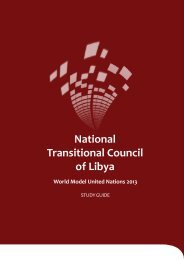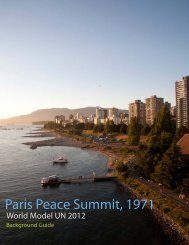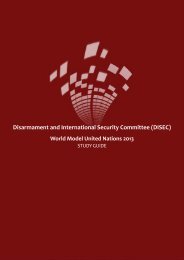Social, Humanitarian and Cultural Committee (SOCHUM)
Social, Humanitarian and Cultural Committee (SOCHUM)
Social, Humanitarian and Cultural Committee (SOCHUM)
Create successful ePaper yourself
Turn your PDF publications into a flip-book with our unique Google optimized e-Paper software.
over the l<strong>and</strong> that they have lived on for centuries.<br />
Another problem is the failure to consult indigenous<br />
communities when developing l<strong>and</strong> rights policies.<br />
Many indigenous communities have their own<br />
local l<strong>and</strong> practices that policymakers completely<br />
disregard in the drafting of their frameworks for l<strong>and</strong><br />
rights. The Samburu of Kenya, for example, use the<br />
Lkiama system, which their ancestors developed<br />
centuries ago. The Lkiama system states that all<br />
tribal l<strong>and</strong>s are collectively owned by the community<br />
<strong>and</strong> entrusts them to a group of elders, who then<br />
distribute them for use to the rest of the tribe. The<br />
Samburu also negotiate directly with other tribes for<br />
l<strong>and</strong>s rights, outside of the jurisdiction of national<br />
laws. The Kenyan government, however, did not take<br />
the Lkiama system or these direct negotiations in<br />
account when developing its new l<strong>and</strong> policy, which<br />
has led to dissention among the Samburu people.<br />
131 Further problems with legal frameworks for local<br />
l<strong>and</strong> rights include overly complicated procedures<br />
for securing these l<strong>and</strong> rights, imprecision in the<br />
definitions of who is entitled to local l<strong>and</strong> rights, <strong>and</strong><br />
conflict over ownership of natural resources within<br />
certain territories. 132<br />
Upon removing indigenous populations from<br />
ancestral l<strong>and</strong>s, governments sometimes resettle<br />
them on l<strong>and</strong>s entirely unfamiliar to the populations.<br />
For example, the Batwa people of Central Africa have<br />
traditionally lived in the forests of Rw<strong>and</strong>a, Ug<strong>and</strong>a,<br />
Burundi, <strong>and</strong> the eastern part of the democratic<br />
Republic of the Congo. In past few decades, these<br />
governments have expelled the Batwa from their<br />
l<strong>and</strong>s because they wished to either undertake a<br />
large infrastructural development program or form<br />
a national park or nature reserve on the territory.<br />
Currently, fewer than 10% of the Batwa still retain<br />
access to traditional forest l<strong>and</strong>s while the rest<br />
have been resettled to villages on the periphery of<br />
mainstream society. 133 These resettled citizens cannot<br />
continue the forms of employment that they used to<br />
undertake in the forest, <strong>and</strong> discrimination from the<br />
majority ethnic group prevents them from obtaining<br />
meaningful work. Most end up working as labor on<br />
other people’s farms <strong>and</strong> have to borrow food in<br />
order to survive. This entraps the Batwa people in a<br />
cycle of debt from which they rarely escape. While<br />
the populations of these African nations are rapidly<br />
rising, the Batwa population is falling, most likely<br />
because of the extreme poverty they face <strong>and</strong> the<br />
subsequent lack of access to food <strong>and</strong> healthcare. 134<br />
The problem of indigenous populations losing their<br />
local l<strong>and</strong> rights is not always forced upon them by<br />
national governments. In some instances, immediate<br />
economic pressures can encourage indigenous<br />
peoples to sell their plots to whomever is willing to pay,<br />
whether it be members of the majority population or a<br />
dominant company. The Olkaria Maasai population of<br />
Kenya, for example, live in Hell’s Gate National Park,<br />
where the Kenya electricity Generating Company<br />
(KenGen), a parastatal organization that produces<br />
the vast majority of the electricity consumed in the<br />
country, has been developing geothermal energy<br />
since before the founding of the park in 1984. After a<br />
long legal dispute, a Kenyan court ruled in 2009 that<br />
the Maasai had rights to the l<strong>and</strong> but, ignoring the<br />
local l<strong>and</strong> customs as discussed above, divided the<br />
l<strong>and</strong> into plots owned by individual members of the<br />
Maasai tribe. While some have retained their l<strong>and</strong> <strong>and</strong><br />
resumed traditional agricultural practices, KenGen<br />
has bought out many others, paying them substantial<br />
amounts for their individual titles. This issue has<br />
brought significant intertribal violence <strong>and</strong> conflict to<br />
the region, as those that do not sell were angry with<br />
those that do. 135 Although it seems that the selling of<br />
individual titles benefits the economic situations of<br />
these Maasai, in the long run it will most likely leave<br />
them in a worse position, as most of them do not<br />
have the education or the skills for other occupations<br />
35<br />
Melbourne Host Directorate PTY LTD | Office of Media <strong>and</strong> Design

















